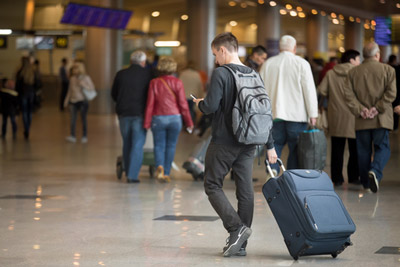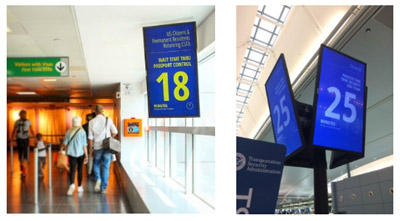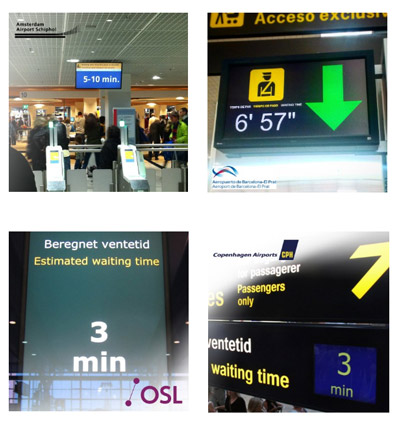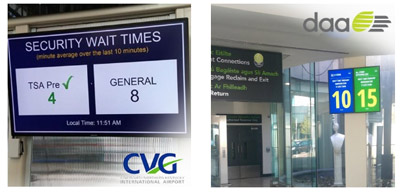Real-time Wait Times at Airport Processes Reduces Passenger Frustration
- Like
- Digg
- Del
- Tumblr
- VKontakte
- Buffer
- Love This
- Odnoklassniki
- Meneame
- Blogger
- Amazon
- Yahoo Mail
- Gmail
- AOL
- Newsvine
- HackerNews
- Evernote
- MySpace
- Mail.ru
- Viadeo
- Line
- Comments
- Yummly
- SMS
- Viber
- Telegram
- Subscribe
- Skype
- Facebook Messenger
- Kakao
- LiveJournal
- Yammer
- Edgar
- Fintel
- Mix
- Instapaper
- Copy Link
Posted: 5 May 2016 | Christian Bugislaus Carstens | No comments yet
Christian Bugislaus Carstens of Veovo looks at how and why several airports are now displaying real-time wait times to relieve stress and improve the passenger experience…


For many, the most stressful part of catching a flight is waiting in line at the airport. As air travel is continually on the rise and airports often have limited space to expand, the pressure on authorities to balance security with a good passenger experience grows. This leads to significant bottlenecks, with delays that frustrate travellers.
The uncertainty around how long airport processes, such as check-in, security, border control and immigration, weighs heavily on the mind, particularly when confronted with what appears to be a lot of travellers in line in front of you.
“The pressure on authorities to balance security with a good passenger experience grows”
But now several airports around the world, including New York’s JFK International, is trying to make it less frustrating – by displaying accurate wait times, on screens placed at TSA Security and Customs and Border Protection checkpoints, as well as the indoor taxi queue.
Daryl Jameson, vice president at the company JFKIAT, which runs Terminal 4 says: “People like to know how long they are going to wait in queues. Nobody likes to wait in lines and signage helps to manage expectations.”


Also Amsterdam Schiphol, Barcelona El-Prat, Copenhagen, Cincinnati, Dublin and Oslo is displaying real-time wait times, to relieve stress and improve the passenger experience.




The wait times are driven by sensors that monitor passenger’s mobile devices as they move through the airport. The solution works by measuring individual travel times, from queue entrance to exit, and the number of people in line. With the two measurements, predicted wait time, for people entering the line, can be calculated and displayed.
Improved operation
Besides being able to provide passengers with wait times, the airports also use the collected data from the sensors to give early warning if lines are becoming congested. This allows management to response promptly and effectively to irregular operations and disruptions, to ultimately reduce processing times.
“The airports also use the collected data from the sensors to give early warning if lines are becoming congested”
“The predictive data has proved to be very accurate, and is used by the staff to monitor the operation and is also the queue time that is displayed on our mobile application and monitors around the airport”, says John Seely, Technology Projects Manager at Dublin Airport.
In addition, the data can be used to provide minute-by-minute live forecasts of waiting times for the remaining hours of the day. It enables airport managers to adjust plans if expected wait times deviate from original forecasts, preventing queue build-up and avoiding potential KPI violations.
Not iBeacons
As the sensors automatically, and without interaction from the travellers, detect mobile devices with enabled Bluetooth or WiFi, the penetration rate is significantly higher (40%) than with iBeacons (1%). In addition, iBeacons require that the traveller downloads a mobile app, in order to work as a tool for queue and flow measurement.
A recent Expedia survey found 94% of leisure traveller’s travel with a mobile device. Considering that 64% of American adults now own a smartphone, monitoring mobile devices is an accurate method for predicting and examining passenger traffic.
“Ensuring that travellers experience a quick and easy passage will significantly increase the opportunity for a positive experience”
Ensuring that travellers experience a quick and easy passage will significantly increase the opportunity for a positive experience, with more satisfied and recurring travellers as a result.
…and as studies show: A passenger is willing to spend up to EUR 1,00 per minute in airport concession, once he/she passes the security process. Consequently, managing queues and flow management, becomes an important tool to generate more non-airline revenue for the airport.
“The solution provides us with immediate visibility to the customer experience and resource effectiveness with throughput planning. It allows us to put the customer at ease at a critical stress point and instilling our expectations around superior customer experience,” says Brian Cobb, Vice President, Customer Experience at Cincinnati Airport.
The solution, named Passenger Predictability and produced by Denmark-based Veovo, is successfully employed in optimisation efforts in more than 25 international airports, including Schiphol Airport in Amsterdam, JFK Airport in New York, Toronto Pearson, Dubai, El-Prat Airport in Barcelona, Dulles Airport in Washington, Copenhagen, Oslo, Malpensa and Linate Airports in Milano, Manchester, Brussels, Dublin, San Diego, Helsinki, Auckland, Montreal, Genève, Birmingham, Bristol, Cincinnati, Brussels South Charleroi, Keflavik, Billund and Aalborg.


















